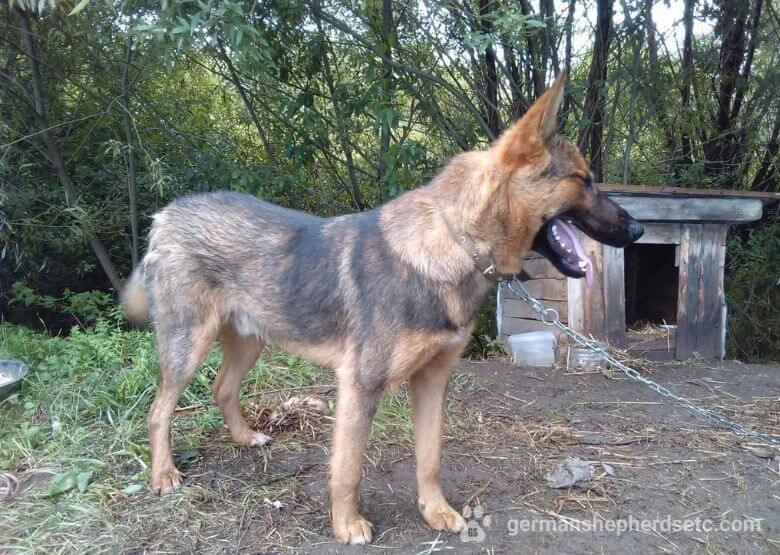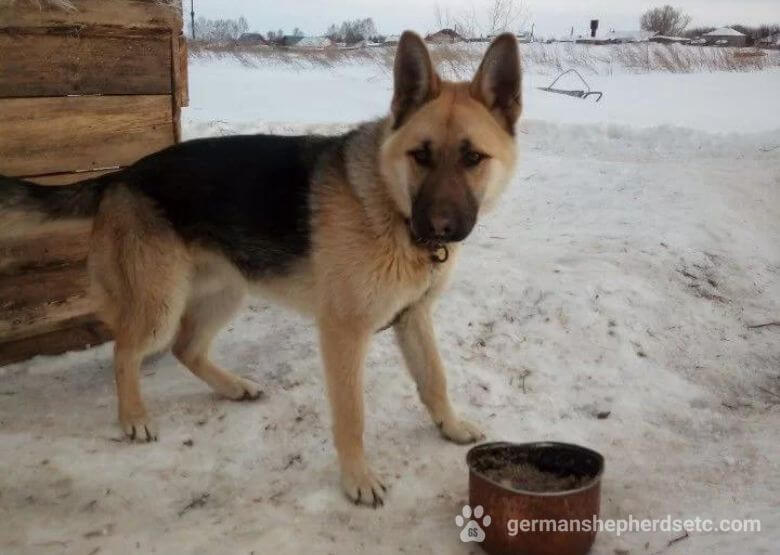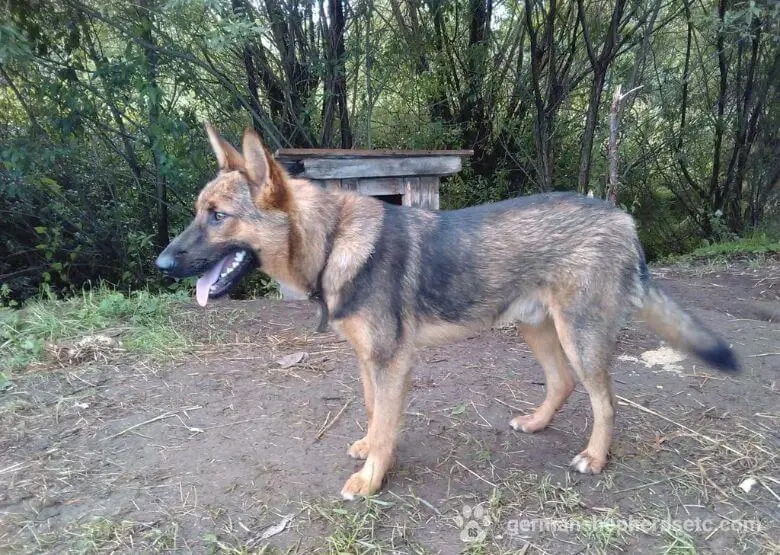Table of Contents
A German Shepherd is an iconic breed. These dogs are best friends, companions, and workers. They are very intelligent, hard-working, and loyal. However, they need a lot of care and attention while raising.
If you are a happy owner of a 10 month old GSD puppy, you need to consider the many things we are talking about in this article. They are not only about your pup’s appearance and behavior. Your task is to do your best to raise your dog to be healthy, strong, and admirable.
Size & Appearance
Your 10 month old German Shepherd has almost reached its adult height and looks like an absolutely grown-up dog. Of course, its growth is not completed. These dogs continue growing until they are 1.5-2 years old. Moreover, they are still filling out.
Usually, a male dog is obviously bigger than a female. The height is measured at the withers. It is in the back section above the shoulders. The male’s height at this age is 55-60 cm (22-23.5 inches). The females are 49 cm (19 inches) tall.
Males are also heavier – 63-73 pounds (28.5-33 kg), while females weigh 57-62 pounds (26-28 kg). The measurements can differ among dogs due to their heredity and keeping conditions, though the parameters should not differ too much. Practice weighing your puppy every week to know whether it develops properly.
Teething usually ends at the age of around 5-8 months, so now your Shepherd has all its 42 adult teeth. Ears stand upright, steady by about 8 months. So, 10 months of age is a critical time for the ears’ setting. You may need to talk to your veterinarian about the possible reasons for it and proper correction or think about the purity of the breed.
The coat is double-layered and entirely adult. It becomes thicker and glossier now and sheds a lot, so regular brushing is a must if you don’t want your house to sink into your dog’s fur.
Activity & Behavior
The essential change you may notice in your 10 month old GSD is increased energy levels. Your pup is an adolescent, very curious and exploring. It may lead to getting into trouble if not managed properly. Interactive games, proper training, and stimulation can help it burn off the excess energy and get controlled.
Your puppy becomes more independent and even tries to test your authority. On the other hand, it gets more protective and eager to guard its territory. It likes socializing with dogs and other animals, but a male can grow aggressive and competitive if another male enters its realm.
A female experiences its first heat (ovulation). Further on, it will come into it twice a year or every 18 months. Every cycle lasts for about 3 weeks. It can make your girl anxious, uncontrolled, and seeking mating with a male. She becomes sexually mature and can produce offspring if you are not careful enough.

Your pup needs a lot of sleep now because it continues growing. 18-20 hours per day is the norm, though it may seem too much to you. Provide your pet with comfortable bedding for its nap times. You may also notice that your doggy does not want to sleep too much during the daytime. It is because of the immense energy it needs to burn out. However, if you suspect that your pup does not get enough sleep, you may need to correct its exercise routine.
Your German Shepherd needs much time for running and playing, too. Provide it with just two hours of intensive exercise per day. However, give it one rest period between the sessions not to overload it with physical activities. Several walks or play sessions will be ideal if you have enough time to do that with your pet. Walking time can be counted by adding 5 minutes to the number of months of age. So, your puppy needs at least 50 minutes of walking per day. The rest of the time can be spent playing fetch or Frisbee. Provide your pet with sufficient mental stimulation, too.
Choose a proper place for walking and let your friend explore the environment or train it to behave properly outdoors. Use interactive toys, nose work, and puzzles to provide enough exercise. Your doggy will become destructive and disobedient if it does not get much physical and mental stimulation.
Buy durable and specifically designed toys. Avoid small sizes to prevent choking. A toy needs to evoke your pup’s predatory instincts. So, it may resemble a bird or a small animal to make playing more interesting. Acquire some toys that can satisfy your Shepherd’s chewing needs. They can help keep teeth clean and healthy; playing with them is always entertaining.
Balls and tug toys are also good choices. You can use balls for fetching and tug toys for interactive games.
Health & Care
So, let’s assume your 10 month old German Shepherd is absolutely healthy. It does not need any vaccination sessions at this age, provided it got all the necessary vaccines when it was 5 months old. The next vaccination will only take place when it is a year old.
However, you had better be aware of possible health issues your doggy may be prone to due to its breed or heredity. This list includes the following:
- Arthritis. This condition is age-related and can cause joint pain and stiffness.
- Allergies. The causes of allergies can differ, but all of them lead to hair loss, itching, ear problems, and redness. They can appear at any age, so you must be alert.
- Hip and elbow dysplasia. This condition is common for Shepherds and can cause pain and lameness. Large dogs like GSs are immensely susceptible to this condition.
- Gastrointestinal problems. They may include vomiting and diarrhea. Your large dog has a fast metabolism, so you need to be careful about any changes in its feeding behavior.
- Cancer. German Shepherds are prone to specific types of this life-threatening disease, like bone cancer and lymphoma, at any age.
Talk to your veterinarian if you see any signs of possible health disorders.
Proper nutrition and care can help avoid many of these issues. You also need to think about spaying for girls and neutering for boys at this age. It is a surgical removal of the reproductive organs. The procedure is safe, and it has many health-related benefits. It reduces territorial roaming, aggression, and risk of cancer. You can prevent uncontrolled litter production and risks of life-threatening behaviors. You can opt for it if you do not intend to mate your dog with a purebred partner.
Feeding

The dietary needs of your 10 month old GSD differ from those of a small dog. It needs the proper combination of minerals, fats, and vitamins for healthy growth. When your pup reaches the age of 10 months, continue feeding it twice per day. If the diet is natural, give preference to animal sources of proteins, like chicken, fish, lamb, pork, beef, and eggs. You can also include vegetables and grains in the diet if your doggy does not have allergies.
Consider the possibility of developing joint problems, so your pup’s food has to contain omega-3 fatty acids to avoid them.
You may also prefer to feed your pet with dry food called kibble. It is more cost-effective, but the food has to be high-quality. You can also give your pup dry and wet food in turn.
If you feed your German Shepherd puppy with kibble, 3-3½ cups are OK. This amount should be spread between the two daily meals. Your dog needs to have access to fresh water all the time, so keep a bowl of water at its feeding place all the time.
Training
Training is essential for your 10 month old German Shepherd because it is very curious and intelligent at this age. It is a quick learner, though a bit stubborn. It may already know the basic commands, like come, stay, and sit. Now, it’s time to introduce more complicated commands, for example, rollover or heel.
Try to be positive while training your doggy. Use treats and praise, but never force your pup to do anything. You must be consistent with all the commands and reinforcements, or your pet will get confused.
The attention span of your puppy is very short at this age due to hormonal changes, so you need to make out some individual ways to keep its attention. Use interactive toys to do that. Don’t speed your doggy up. Give it more time to acquire new skills.
You can motivate your pet with treats but don’t overuse them. They have to be small, soft pieces that are easy to eat. Too many treats can cause weight gain. The most common treats dogs love include cheese, chicken meat cut into small chunks, and vegetables, like carrots or green beans, also chopped properly.
FAQ
How much exercise does a 10 month old German Shepherd need?
Your doggy needs at least 2 hours of exercise per day at this age. You can spread it between two or more sessions. Walking can take about 50 minutes (5 minutes for every month of age).
Do German Shepherds grow after 10 months?
Even if it seems to you that your pet looks like an adult dog, it will continue to grow after 10 months. Most dogs reach full physical maturity at the age of two, and some even continue growing until they are three. They need this time to fill out and build their muscles.
Final Thoughts
You are the owner of the best dog in the world, and you already know your pet’s habits and specific needs. However, when we speak about a 10 month old German Shepherd, you need some more knowledge because you deal with an adolescent influenced strongly by hormones. So, taking care of it requires even more accuracy and consideration.
We hope that the information provided in this article will help you a lot to ensure that you are doing everything correctly and your doggy will grow up healthy, strong, intelligent, and obedient. You need to follow them and always talk to experts to enjoy a happy life with your perfect furry friend.
